Underdetermined DOA Estimation Using MVDR-Weighted LASSO
Abstract
:1. Introduction
Notations
2. Difference Co-Array
3. Compressive Sensing Framework
4. Modified LASSO for DOA Estimation
- Let the initial estimate for be .
- Find , where the n-th element of , , is given by .
- Define matrix , such that its -th element is given by , where and .
- Solve the LASSO problem as:
- Calculate .
4.1. OLS A-LASSO
4.2. MVDR A-LASSO
4.3. Wideband MVDR A-LASSO DOA
4.4. Selecting the Regularization Parameter
5. Simulation Results
5.1. Narrowband Signal Sources
5.1.1. Investigations of LASSO-Based Algorithms
5.1.2. Investigations of A-LASSO Algorithms
5.1.3. Investigations of the MVDR A-LASSO Algorithm
5.2. Wideband Signal Sources
6. Conclusions
Acknowledgments
Author Contributions
Conflicts of Interest
References
- Khmou, Y.; Safi, S.; Frikel, M. Comparative study between several direction of arrival estimation methods. J. Telecommun. Inf. Technol. 2014, 1, 41–48. [Google Scholar]
- Chen, Z.; Gokeda, G.; Yu, Y. Overview of Basic DOA Estimation Algorithms. In Introduction to Direction-of-Arrival Estimation; Artech House: Norwood, MA, USA, 2010; pp. 31–64. [Google Scholar]
- Capon, J. High-resolution frequency-wavenumber spectrum analysis. Proc. IEEE 1969, 57, 1408–1418. [Google Scholar] [CrossRef]
- Makhoul, J. Linear prediction: A tutorial review. Proc. IEEE 1975, 63, 561–580. [Google Scholar] [CrossRef]
- Ziskind, I.; Wax, M. Maximum likelihood localization of multiple sources by alternating projection. IEEE Trans. Acoust. Speech Signal Proc. 1998, 36, 1553–1560. [Google Scholar] [CrossRef]
- Schmidt, R.O. Multiple emitter location and signal parameter estimation. IEEE Trans. Antennas Propag. 1986, 34, 276–280. [Google Scholar] [CrossRef]
- Roy, R.; Kailath, T. ESPRIT-estimation of signal parameters via rotational invariance techniques. IEEE Trans. Acoust. Speech Signal Proc. 1989, 37, 984–995. [Google Scholar] [CrossRef]
- Sidiropoulos, N.D.; Bro, R.; Giannakis, G.B. Parallel factor analysis in sensor array processing. IEEE Trans. Signal Proc. 2000, 48, 2377–2388. [Google Scholar] [CrossRef]
- Nion, D.; Sidiropoulos, N.D. A PARAFAC-based technique for detection and localization of multiple targets in a MIMO radar system. In Proceedings of the 2009 IEEE International Conference on Acoustics, Speech and Signal Processing, Taipei, Taiwan, 19–24 April 2009; pp. 2077–2080.
- Guizzo, E. How Google’S Self-Driving Car Works. Available online: http://spectrum.ieee.org/automaton/robotics/artificial-intelligence/how-google-self-driving-car-works (accessed on 16 August 2016).
- Liang, J. Joint azimuth and elevation direction finding using cumulant. IEEE Sens. J. 2009, 9, 390–398. [Google Scholar] [CrossRef]
- Ma, W.-K.; Hsieh, T.-H.; Chi, C.-Y. DOA estimation of quasi-stationary signals via Khatri-Rao subspace. In Proceedings of the 2009 IEEE International Conference on Acoustics, Speech and Signal Processing, Taipei, Taiwan, 19–24 April 2009; pp. 2165–2168.
- Ma, W.-K.; Hsieh, T.-H.; Chi, C.-Y. DOA estimation of quasi-stationary signals with less sensors than sources and unknown spatial noise covariance: A Khatri-Rao subspace approach. IEEE Trans. Signal Proc. 2010, 58, 2168–2180. [Google Scholar] [CrossRef]
- Pal, P.; Vaidyanathan, P.P. Nested arrays: A novel approach to array processing with enhanced degrees of freedom. IEEE Trans. Signal Proc. 2010, 58, 4167–4181. [Google Scholar] [CrossRef]
- Zhu, C.; Wang, W.-Q.; Chen, H.; So, H.C. Impaired Sensor Diagnosis, Beamforming, and DOA Estimation With Difference Co-Array Processing. IEEE Sens. J. 2015, 15, 3773–3780. [Google Scholar] [CrossRef]
- Pillai, S.U.; Bar-Ness, Y.; Haber, F. A new approach to array geometry for improved spatial spectrum estimation. Proc. IEEE 1985, 73, 1522–1524. [Google Scholar] [CrossRef]
- Pillai, S.; Haber, F. Statistical analysis of a high resolution spatial spectrum estimator utilizing an augmented covariance matrix. IEEE Trans. Acoust. Speech Signal Proc. 1987, 35, 1517–1523. [Google Scholar] [CrossRef]
- Moffet, A. Minimum-redundancy linear arrays. IEEE Trans. Antennas Propag. 1968, 16, 172–175. [Google Scholar] [CrossRef]
- Abramovich, Y.I.; Gray, D.A.; Gorokhov, A.Y.; Spencer, N.K. Positive-definite Toeplitz completion in DOA estimation for nonuniform linear antenna arrays. Fully augmentable arrays. IEEE Trans. Signal Proc. 1998, 46, 2458–2471. [Google Scholar] [CrossRef]
- Zhang, Y.D.; Amin, M.G.; Himed, B. Sparsity-based DOA estimation using co-prime arrays. In Proceedings of the 2013 IEEE International Conference on Acoustics, Speech and Signal Processing, Vancouver, BC, Canada, 26–31 May 2013; pp. 3967–3971.
- Adhikari, K.; Buck, J.R.; Wage, K.E. Beamforming with extended co-prime sensor arrays. In Proceedings of the 2013 IEEE International Conference on Acoustics, Speech and Signal Processing, Vancouver, BC, Canada, 26–31 May 2013; pp. 4183–4184.
- Shen, Q.; Liu, W.; Cui, W.; Wu, S.; Zhang, Y.D.; Amin, M.G. Low-complexity direction-of-arrival estimation based on wideband co-prime arrays. IEEE/ACM Trans. Audio Speech Lang. Proc. 2015, 23, 1445–1456. [Google Scholar] [CrossRef]
- Vaidyanathan, P.P.; Pal, P. Sparse sensing with co-prime samplers and arrays. IEEE Trans. Signal Proc. 2011, 59, 573–586. [Google Scholar] [CrossRef]
- Lustig, M.; Donoho, D.; Pauly, J.M. Sparse MRI: The application of compressed sensing for rapid MR imaging. Magn. Reson. Med. 2007, 58, 1182–1195. [Google Scholar] [CrossRef] [PubMed]
- Wagner, N.; Eldar, Y.C.; Friedman, Z. Compressed beamforming in ultrasound imaging. J. Abbr. 2012, 60, 4643–4657. [Google Scholar] [CrossRef]
- Herman, M.A.; Strohmer, T. High-resolution radar via compressed sensing. IEEE Trans. Signal Proc. 2009, 57, 2275–2284. [Google Scholar] [CrossRef]
- Malioutov, D.; Çetin, M.; Willsky, A.S. A sparse signal reconstruction perspective for source localization with sensor arrays. IEEE Trans. Signal Proc. 2005, 53, 3010–3022. [Google Scholar] [CrossRef]
- Xenaki, A.; Gerstoft, P.; Mosegaard, K. Compressive beamforming. J. Acoust. Soc. Am. 2014, 136, 260–271. [Google Scholar] [CrossRef] [PubMed]
- Gerstoft, P.; Xenaki, A.; Mecklenbräuker, C.F. Single and multiple snapshot compressive beamforming. J. Acoust. Soc. Am. 2015, 138, 2003–2014. [Google Scholar] [CrossRef] [PubMed]
- Tibshirani, R. Regression shrinkage and selection via the lasso. J. R. Stat. Soc. Ser. B (Methodol.) 1996, 58, 267–288. [Google Scholar]
- Zou, H. The adaptive lasso and its oracle properties. J. Am. Stat. Assoc. 2006, 101, 1418–1429. [Google Scholar] [CrossRef]
- Panahi, A.; Viberg, M. On the resolution of the LASSO-based DOA estimation method. In Proceedings of the 2011 International ITG Workshop on Smart Antennas (WSA), Aachen, Germany, 24–25 February 2011; pp. 1–5.
- Liu, S.; Trenkler, G. Hadamard, Khatri-Rao, Kronecker and other matrix products. Int. J. Inf. Syst. Sci. 2008, 4, 160–177. [Google Scholar]
- Van Trees, H.L. Adaptive Beamformers. In Optimum Array Processing, Part IV; WILEY: New York, NY, USA, 2004; pp. 710–916. [Google Scholar]
- Fan, J.; Li, R. Variable selection via nonconcave penalized likelihood and its oracle properties. J. Am. Stat. Assoc. 2001, 96, 1348–1360. [Google Scholar] [CrossRef]
- Chen, S.S.; Donoho, D.L.; Saunders, M.A. Atomic decomposition by basis pursuit. SIAM J. Sci. Comput. 1998, 20, 33–61. [Google Scholar] [CrossRef]
- Efron, B.; Hastie, T.; Johnstone, I.; Tibshirani, R. Least angle regression. Ann. Stat. 2004, 32, 407–499. [Google Scholar]
- Elad, M. The Quest for a Dictionary. In Sparse and Redundant Representations; Editor, F., Meditor, A., Eds.; Springer: New York, NY, USA, 2010; pp. 227–246. [Google Scholar]
- Sinha, P.; George, A.D.; Kim, K. Parallel algorithms for robust broadband MVDR beamforming. J. Comput. Acoust. 2002, 10, 69–96. [Google Scholar] [CrossRef]
- Balakrishnan, S.; Ong, L.T. GNU radio based digital beamforming system: BER and computational performance analysis. In Proceedings of the 2015 23rd European Signal Processing Conference (EUSIPCO), Nice, France, 31 August–4 September 2015; pp. 1596–1600.
- Lavate, T.B.; Kokate, V.K.; Sapkal, A.M. Performance analysis of MUSIC and ESPRIT DOA estimation algorithms for adaptive array smart antenna in mobile communication. In Proceedings of the 2010 2nd International Conference on Computer and Network Technology (ICCNT), Bangkok, Thailand, 23–25 April 2010; pp. 308–311.
- Priyadarshini, M.P.; Vinutha, R. Comparative performance analysis of MUSIC and ESPRIT on ULA. In Proceedings of the 2012 International Conference on Radar, Communication and Computing (ICRCC), Tiruvannamalai, India, 21–22 December 2012; pp. 120–124.
- Mujahid, U.; Mukhtar, M.; Ahmed, J.; Rehman, A.; Abbas, M.; Shahid, U. Spectral estimation for smart antenna system. In Proceedings of the 2013 3rd International Conference on Computer, Control & Communication (IC4), Karachi, Pakistan, 25–26 September 2013; pp. 1–5.
- Wax, M.; Shan, T.-J.; Kailath, T. Spatio-Temporal Spectral Analysis by Eigenstructure Methods. IEEE Trans. Acoust. Speech Signal Proc. 1984, 32, 817–827. [Google Scholar] [CrossRef]
- Yamada, H.; Shirai, S.; Yamaguchi, Y. DOA estimation of wideband signals using extended virtual array. In Proceedings of the 2014 3rd Asia-Pacific Conference on Antennas and Propagation (APCAP), Harbin, China, 26–29 July 2014; pp. 802–805.
- Morozov, V.A. On the solution of functional equations by the method of regularization. Soviet Math. Dokl. 1966, 7, 414–417. [Google Scholar]
- Rust, B.W. Truncated Singular Value Decomposition Solution to Discrete Ill-Posed Problems with Ill-determined Numerical Rank. SIAM J. Sci. Stat. Comput. 1990, 11, 503–518. [Google Scholar]
- Vogel, C.R. Regularization Parameter Selection Methods. In Computational Methods for Inverse Problems; SIAM: Philadelphia, PA, USA, 2002; pp. 97–127. [Google Scholar]
- Wahba, G. Practical approximate solutions to linear operator equations when the data are noisy. SIAM J. Numer. Anal. 1977, 14, 651–667. [Google Scholar] [CrossRef]
- Hansen, P.C.; Jensen, T.K.; Rodriguez, G. An adaptive pruning algorithm for the discrete L-curve criterion. J. Comput. Appl. Math. 2007, 198, 483–492. [Google Scholar] [CrossRef]
- Hansen, P.C.; O’Leary, D.P. The use of the L-curve in the regularization of discrete ill-posed problems. SIAM J. Sci. Comput. 1993, 14, 1487–1503. [Google Scholar] [CrossRef]
- Leming, Q.; Partha, R. Determination of regularization parameter using L-curve by the LARS-LASSO algorithm. In Proceedings of the 2006 Joint Statistical Meetings, Seattle, WA, USA, 6–10 August 2006.
- Grant, M.; Boyd, S. CVX: Matlab Software for Disciplined Convex Programming, Version 2.1. Available online: http://cvxr.com/cvx (accessed on 20 March 2014).
- Grant, M.; Boyd, S. Graph implementations for nonsmooth convex programs. In Recent Advances in Learning and Control; Blondel, V., Boyd, S., Kimura, H., Eds.; Lecture Notes in Control and Information Sciences; Springer: Heidelberg, Germany, 2008; pp. 95–110. [Google Scholar]
- Tütüncü, R.H.; Toh, K.C.; Todd, M.J. Solving semidefinite-quadratic-linear programs using SDPT3. Math. Program. 2003, 95, 189–217. [Google Scholar] [CrossRef]
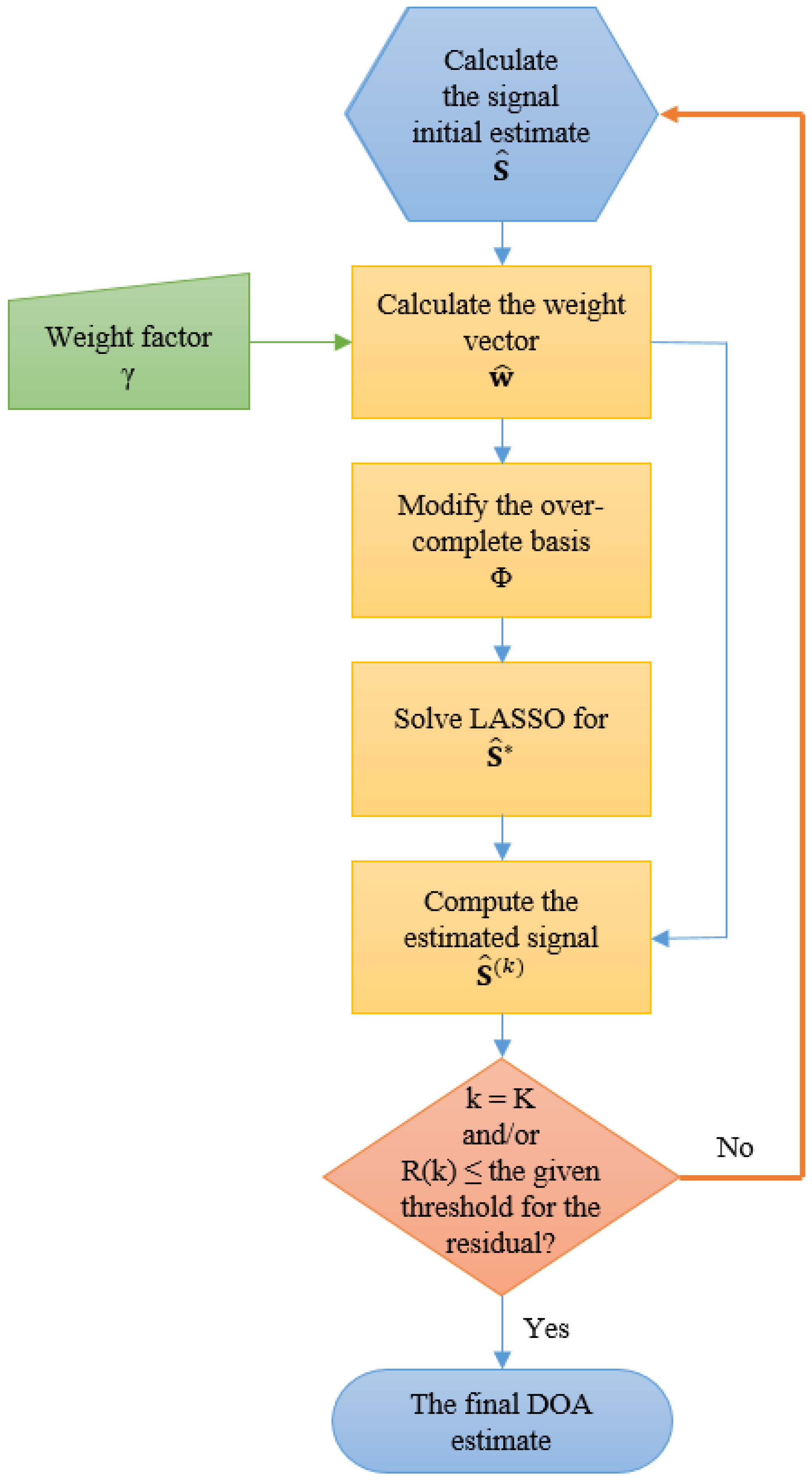
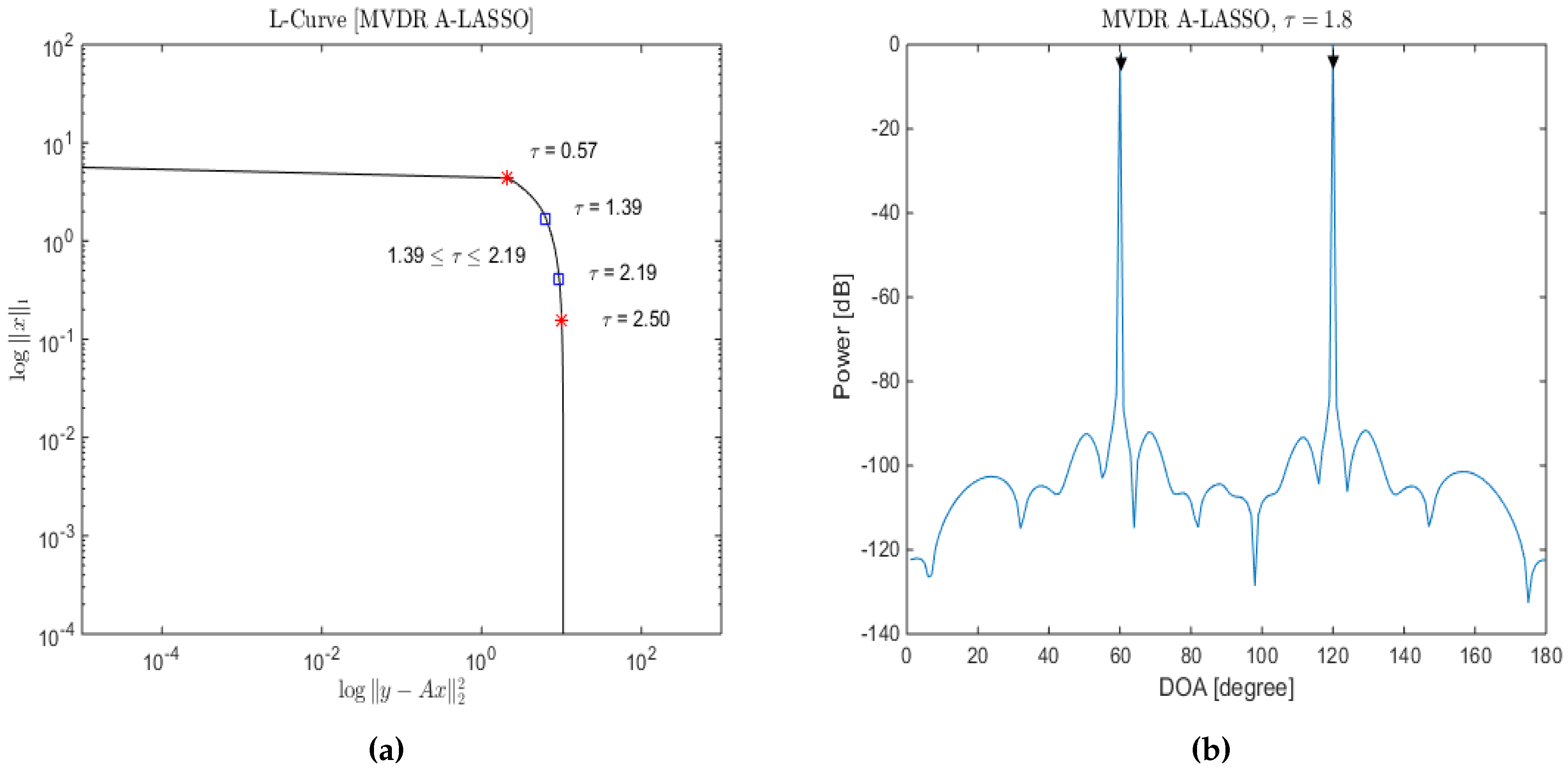
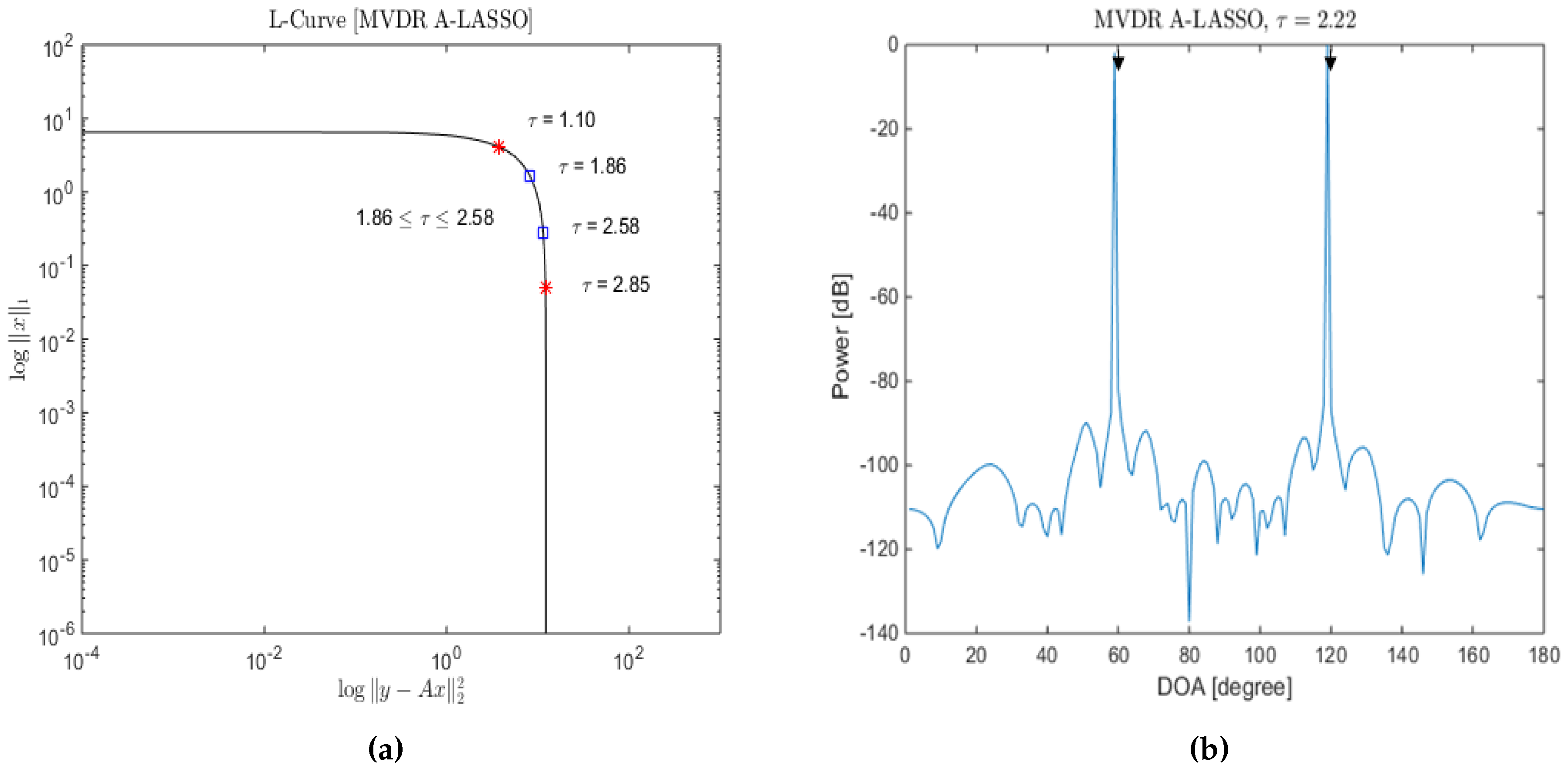

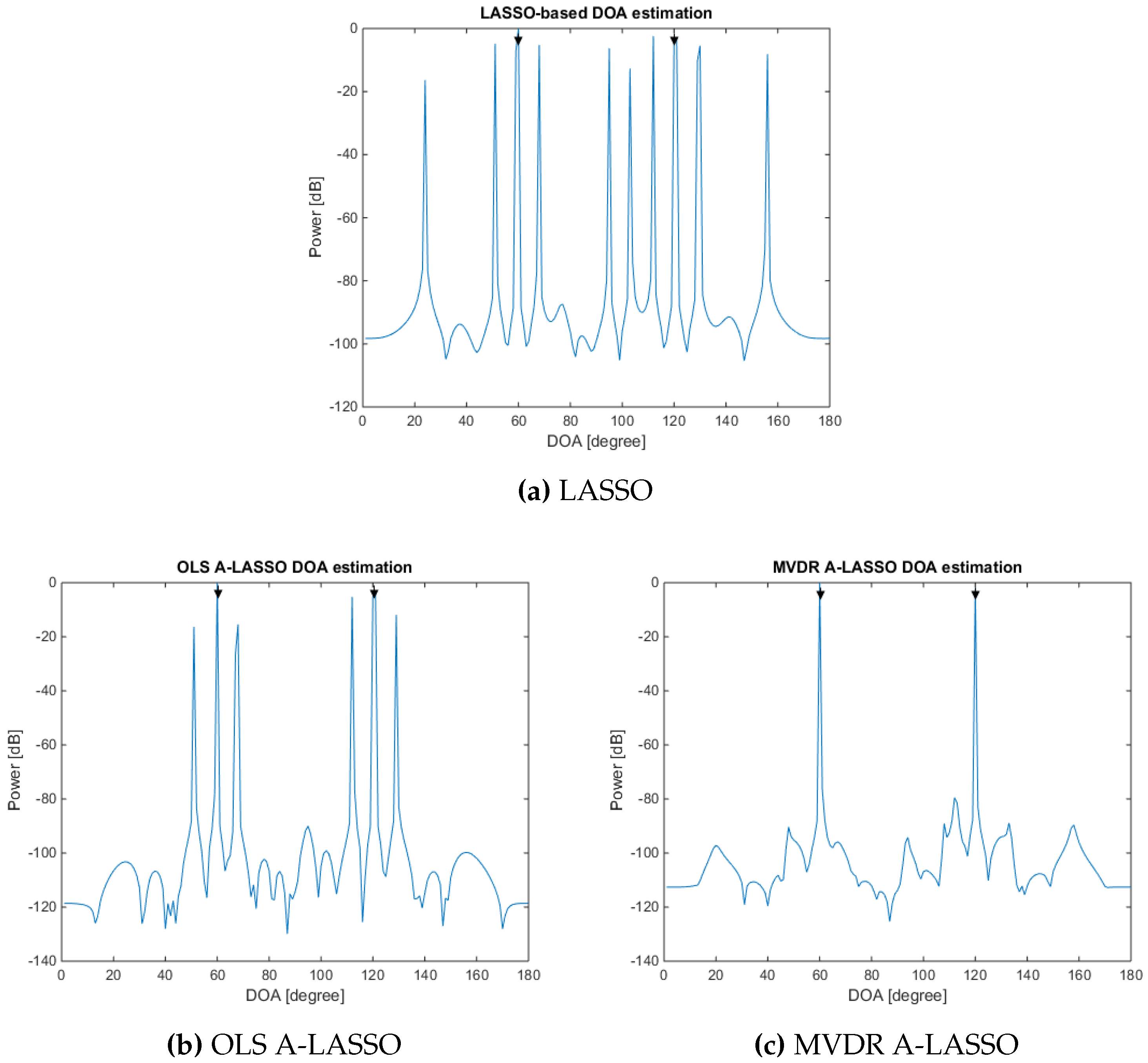
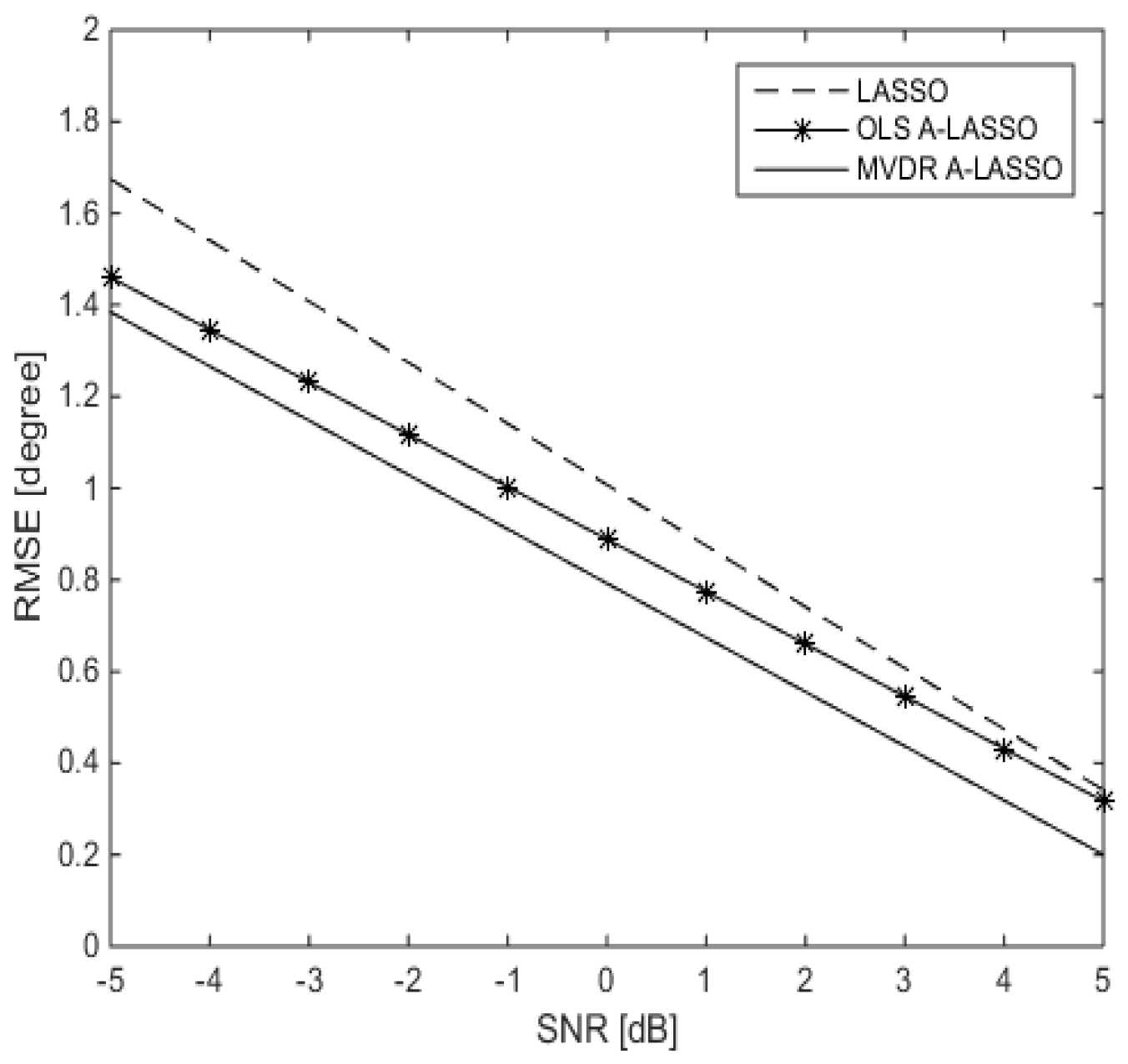



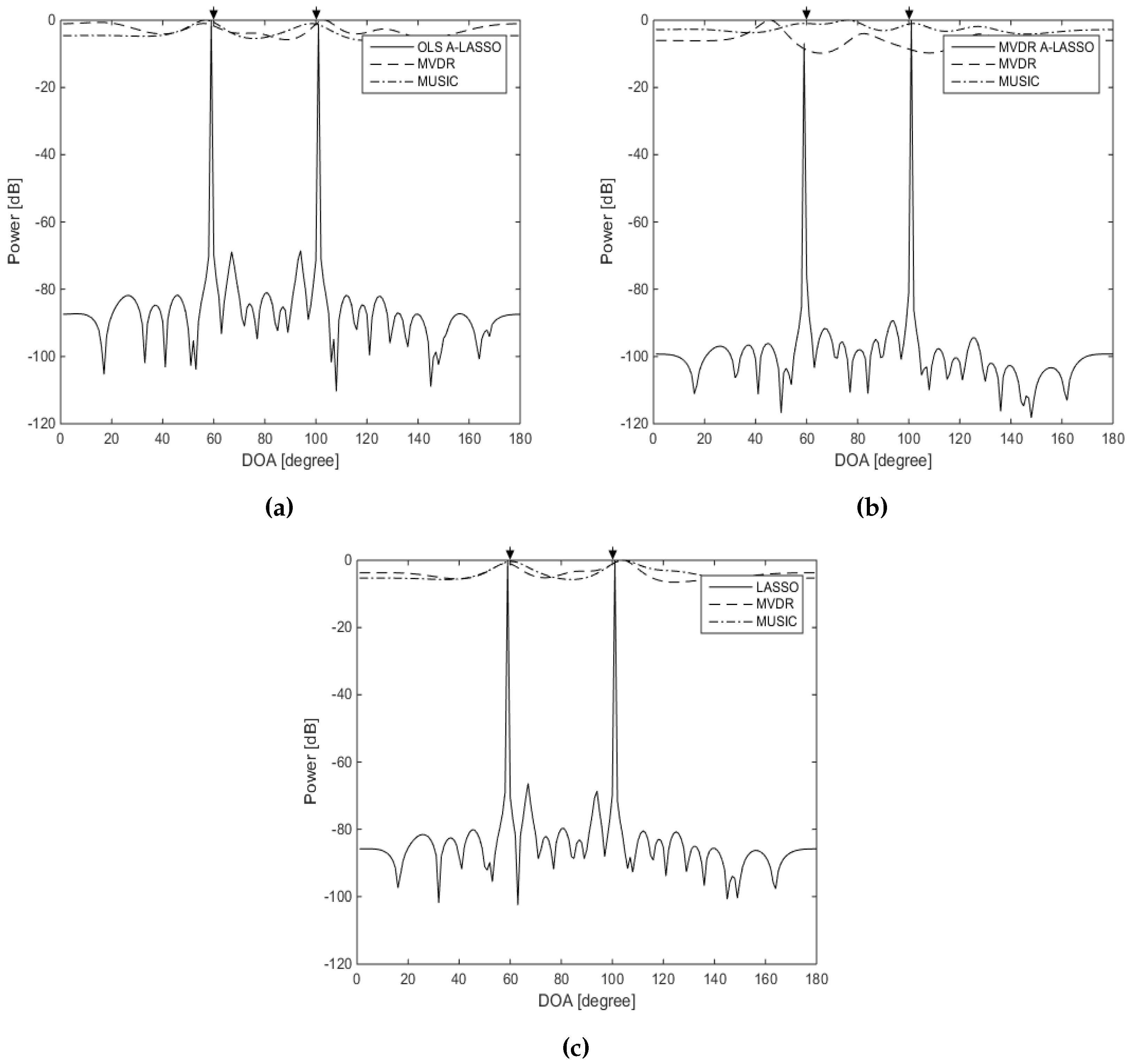
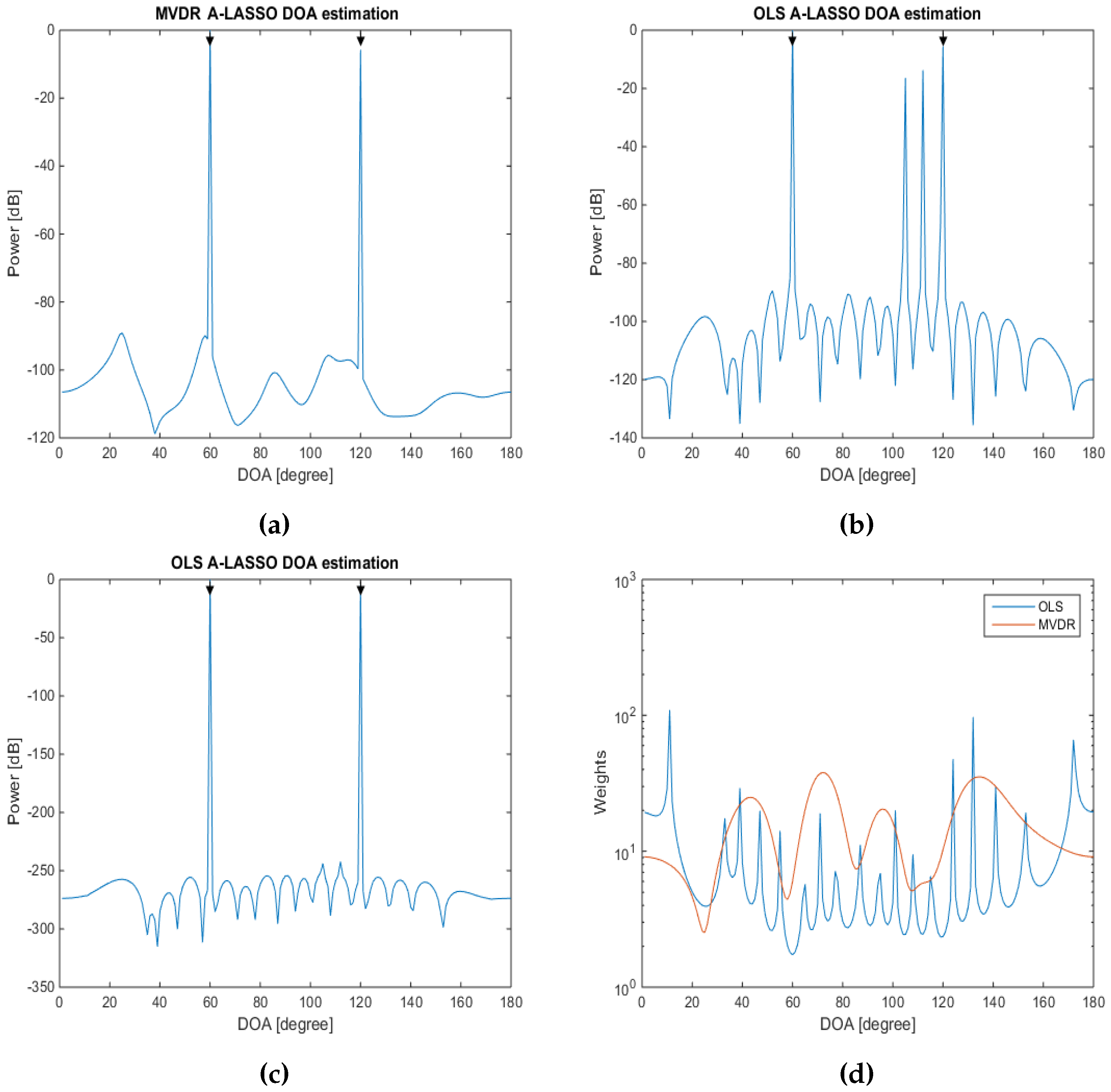
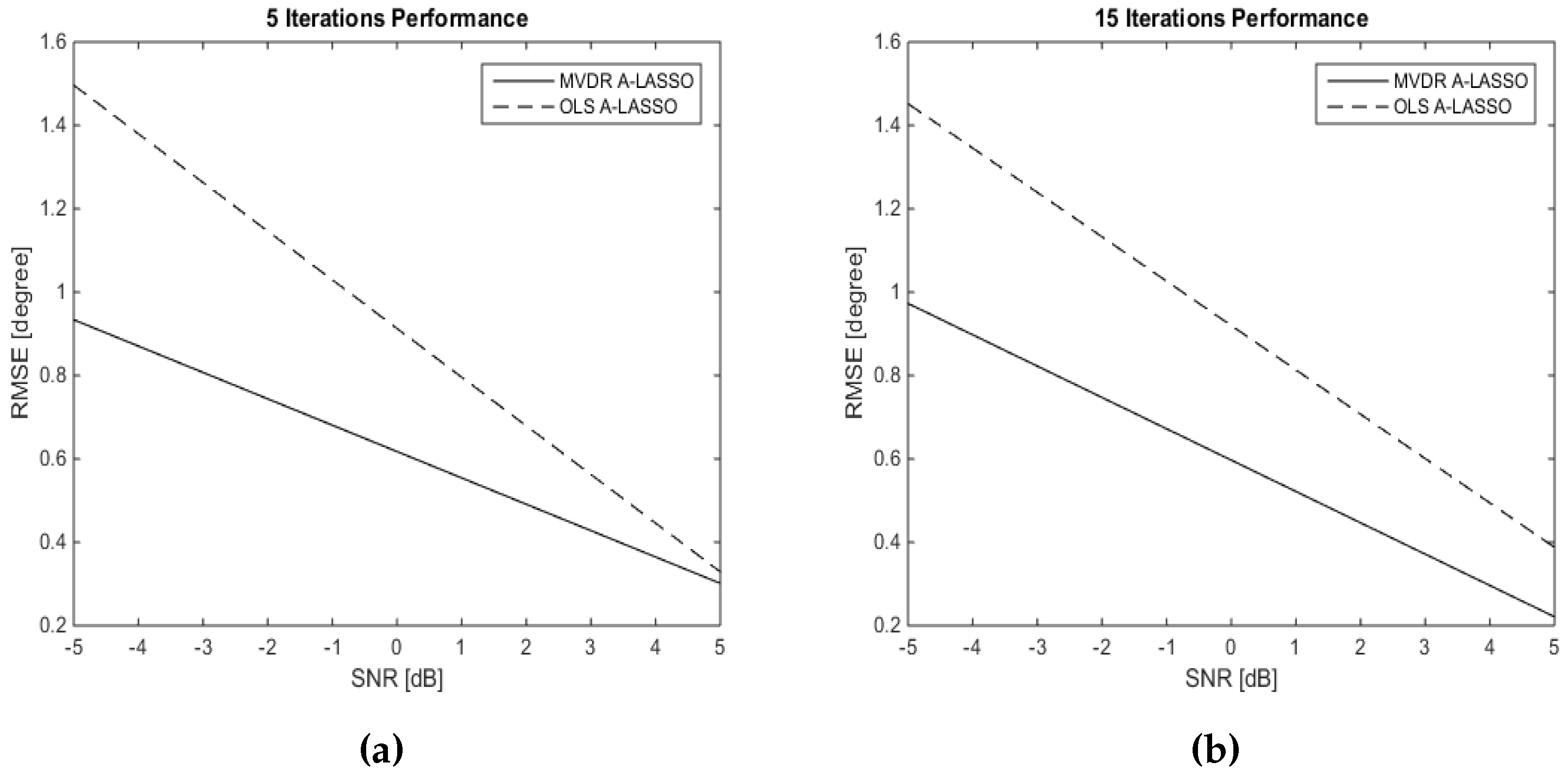

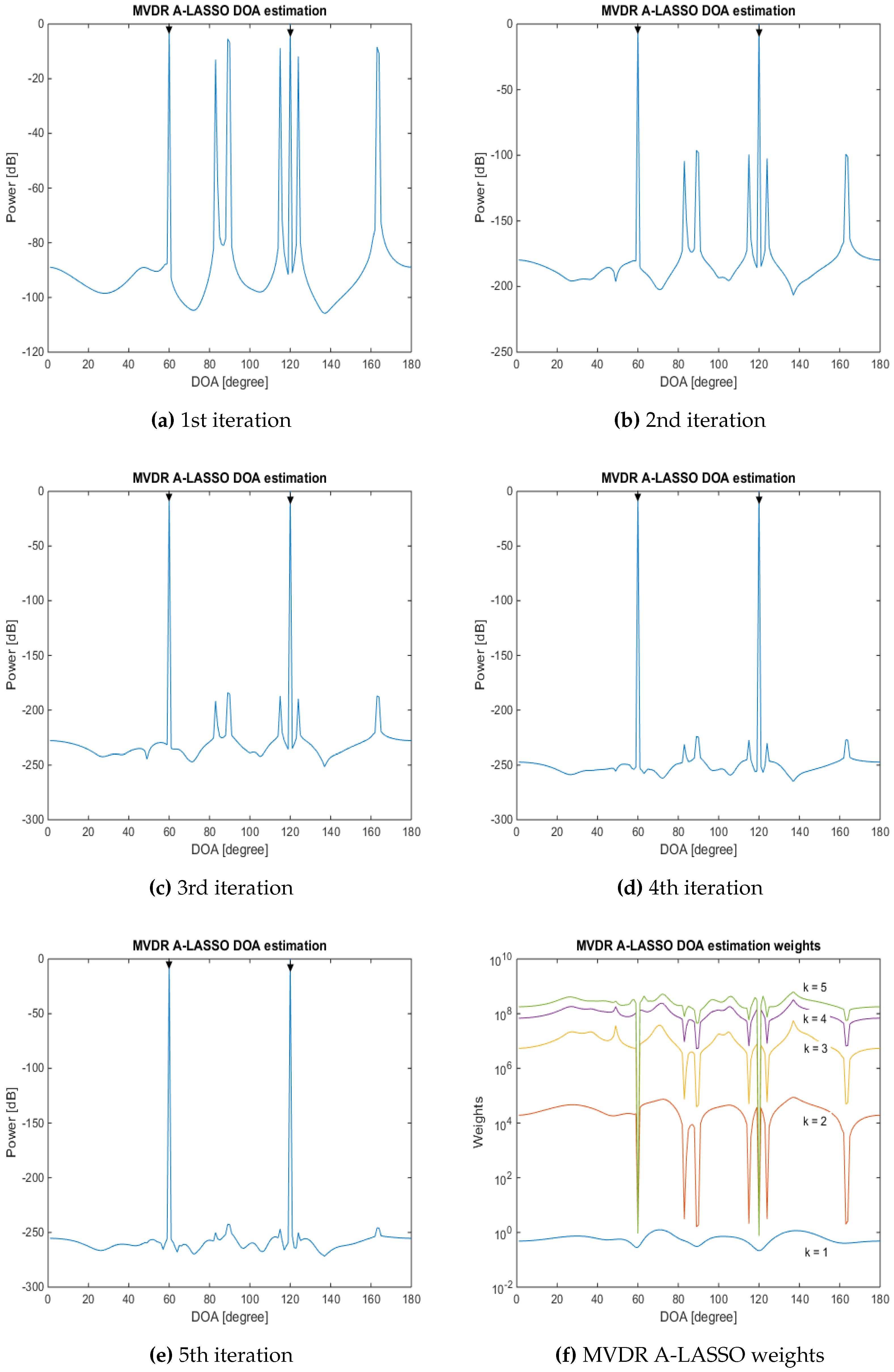
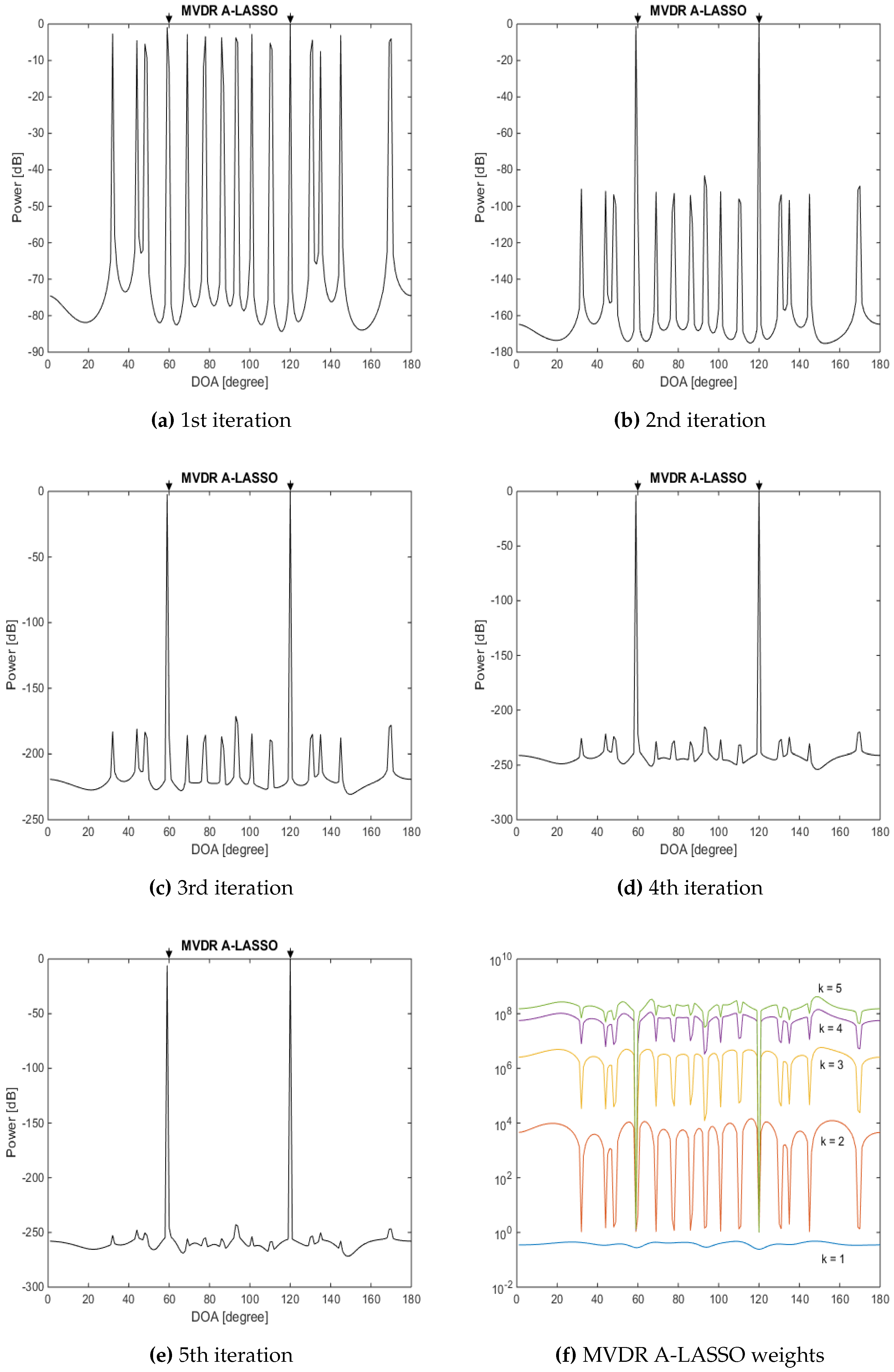
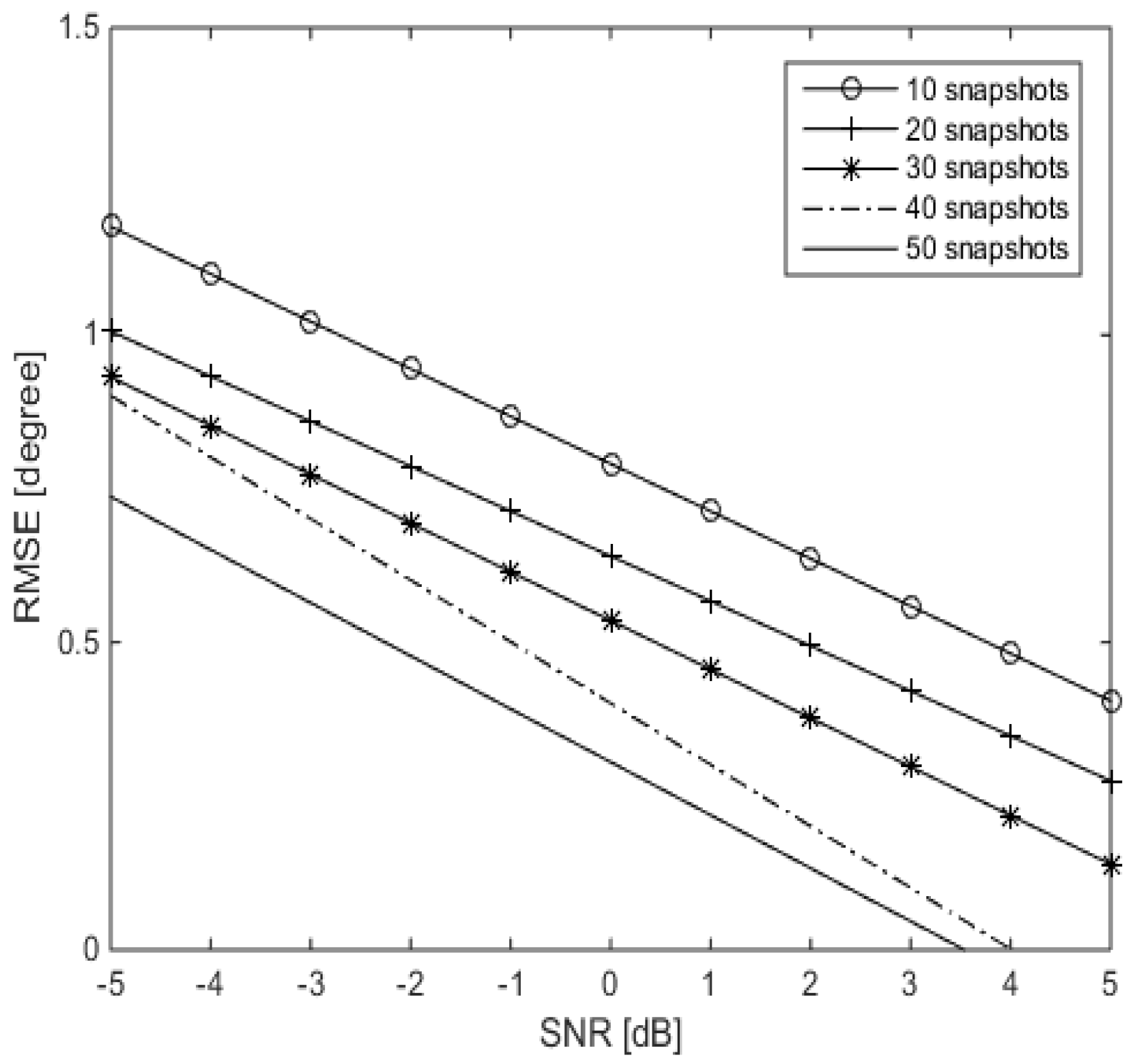




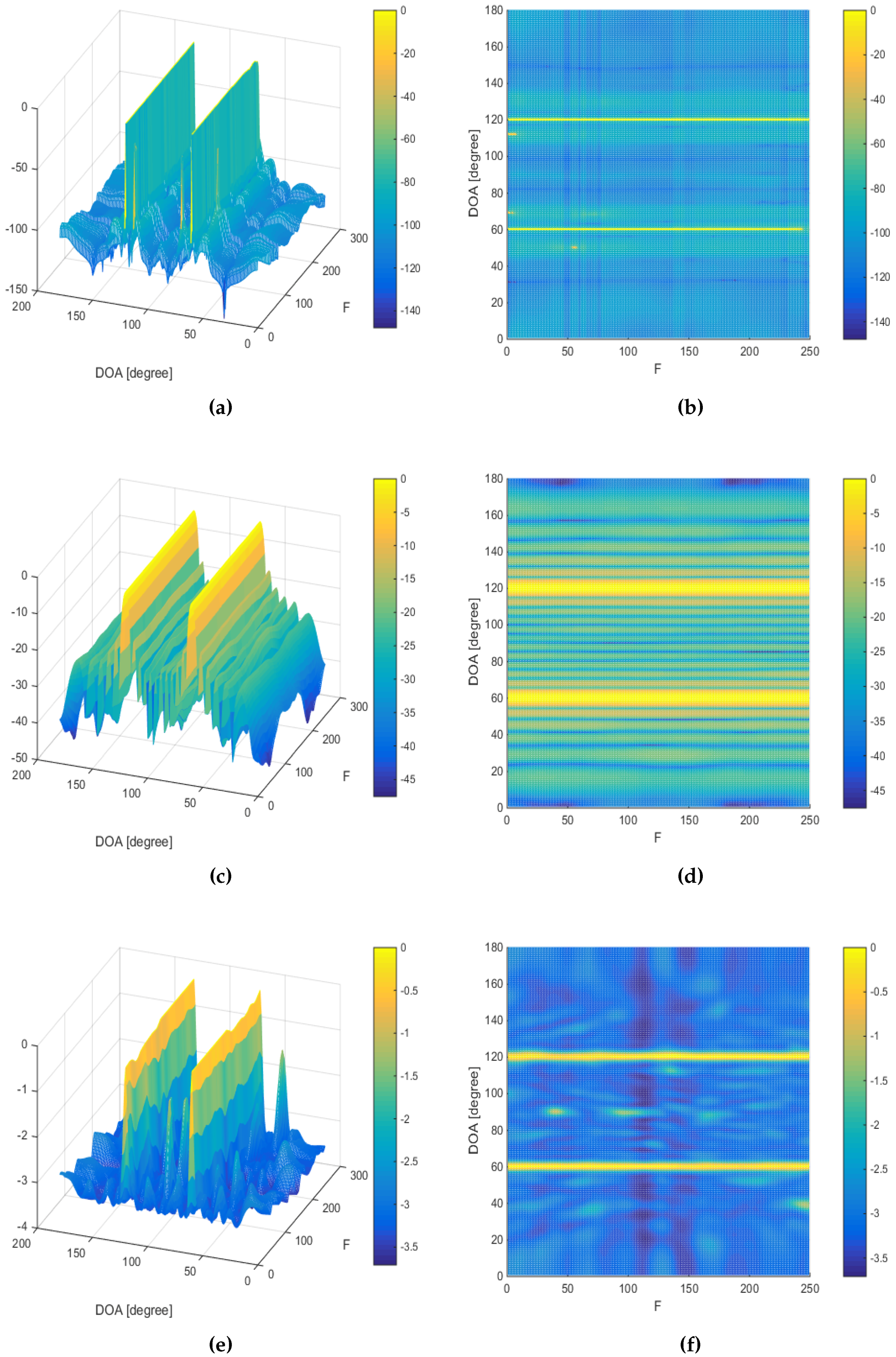
| Operation | Computation | Cost |
|---|---|---|
| Inverse Covariance Matrix | ||
| Beamformer Weight | ||
| Beamformer Sum |
© 2016 by the authors; licensee MDPI, Basel, Switzerland. This article is an open access article distributed under the terms and conditions of the Creative Commons Attribution (CC-BY) license (http://creativecommons.org/licenses/by/4.0/).
Share and Cite
Salama, A.A.; Ahmad, M.O.; Swamy, M.N.S. Underdetermined DOA Estimation Using MVDR-Weighted LASSO. Sensors 2016, 16, 1549. https://doi.org/10.3390/s16091549
Salama AA, Ahmad MO, Swamy MNS. Underdetermined DOA Estimation Using MVDR-Weighted LASSO. Sensors. 2016; 16(9):1549. https://doi.org/10.3390/s16091549
Chicago/Turabian StyleSalama, Amgad A., M. Omair Ahmad, and M. N. S. Swamy. 2016. "Underdetermined DOA Estimation Using MVDR-Weighted LASSO" Sensors 16, no. 9: 1549. https://doi.org/10.3390/s16091549






